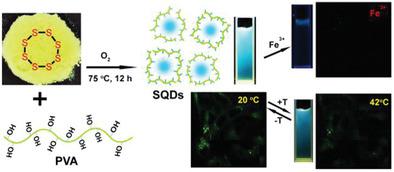当前位置:
X-MOL 学术
›
Part. Part. Syst. Charact.
›
论文详情
Our official English website, www.x-mol.net, welcomes your feedback! (Note: you will need to create a separate account there.)
Polyvinyl Alcohol Enhanced Fluorescent Sulfur Quantum Dots for Highly Sensitive Detection of Fe3+ and Temperature in Cells
Particle & Particle Systems Characterization ( IF 2.7 ) Pub Date : 2021-03-07 , DOI: 10.1002/ppsc.202000332 Jiehao Lei 1 , Zeming Huang 1 , Pengxiang Gao 1 , Jiahui Sun 1 , Li Zhou 1
Particle & Particle Systems Characterization ( IF 2.7 ) Pub Date : 2021-03-07 , DOI: 10.1002/ppsc.202000332 Jiehao Lei 1 , Zeming Huang 1 , Pengxiang Gao 1 , Jiahui Sun 1 , Li Zhou 1
Affiliation

|
As a new class of metal‐free fluorescent dots, sulfur quantum dots (SQDs) have attracted more and more attention because of their unique properties and promising applications in many fields. However, synthesizing SQDs with high optical stability and stimuli‐responsive fluorescence is still in its infancy. Herein, a simple one‐pot strategy is reported for preparing polyvinyl alcohol (PVA)‐capped SQDs from cheap elemental sulfur by employing PVA as ligand. The as‐prepared SQDs with size in range of 1.5–5 nm show fine water dispersibility and stability, bright fluorescence, good optical stability, and low cytotoxicity, which make them potential for cell imaging. In addition, the SQDs show sensitive and selective fluorescence quenching behavior toward Fe3+ with a detection limit of 92 × 10−9 m. Meanwhile, the SQDs also present temperature‐dependent fluorescence and hold promise for working as a nanothermometer. For the first time, the utilization of SQDs for monitoring of Fe3+ and temperature in the interior of cells is confirmed in this study. This work thus opens new opportunities for expanding the application fields of SQDs.
中文翻译:

聚乙烯醇增强的荧光硫原子量子点可用于细胞中Fe3 +和温度的高灵敏检测
作为一类新型的无金属荧光点,硫量子点(SQD)由于其独特的性能和在许多领域的广阔应用而受到越来越多的关注。但是,合成具有高光学稳定性和刺激性荧光的SQD仍处于起步阶段。本文报道了一种简单的单锅策略,即通过使用PVA作为配体,从廉价的元素硫中制备聚乙烯醇(PVA)封端的SQD。制备的SQD尺寸在1.5-5 nm之间,显示出良好的水分散性和稳定性,明亮的荧光,良好的光学稳定性和低细胞毒性,使其具有用于细胞成像的潜力。此外,SQD对Fe 3+表现出灵敏且选择性的荧光猝灭行为,检出限为92×10 -9 米。同时,SQD还呈现出温度依赖性的荧光,并有望用作纳米温度计。这项研究首次证实了利用SQDs监测细胞内部的Fe 3+和温度。因此,这项工作为扩展SQD的应用领域提供了新的机会。
更新日期:2021-04-19
中文翻译:

聚乙烯醇增强的荧光硫原子量子点可用于细胞中Fe3 +和温度的高灵敏检测
作为一类新型的无金属荧光点,硫量子点(SQD)由于其独特的性能和在许多领域的广阔应用而受到越来越多的关注。但是,合成具有高光学稳定性和刺激性荧光的SQD仍处于起步阶段。本文报道了一种简单的单锅策略,即通过使用PVA作为配体,从廉价的元素硫中制备聚乙烯醇(PVA)封端的SQD。制备的SQD尺寸在1.5-5 nm之间,显示出良好的水分散性和稳定性,明亮的荧光,良好的光学稳定性和低细胞毒性,使其具有用于细胞成像的潜力。此外,SQD对Fe 3+表现出灵敏且选择性的荧光猝灭行为,检出限为92×10 -9 米。同时,SQD还呈现出温度依赖性的荧光,并有望用作纳米温度计。这项研究首次证实了利用SQDs监测细胞内部的Fe 3+和温度。因此,这项工作为扩展SQD的应用领域提供了新的机会。


























 京公网安备 11010802027423号
京公网安备 11010802027423号